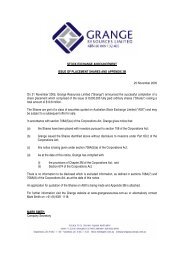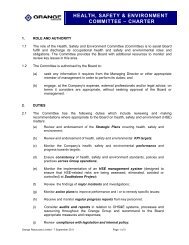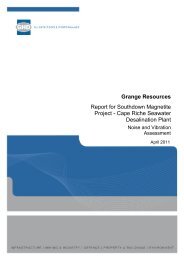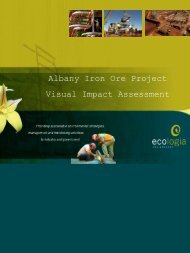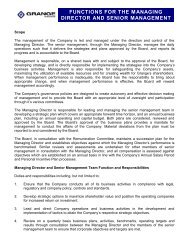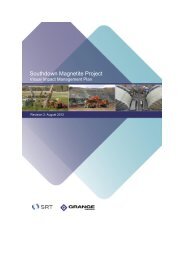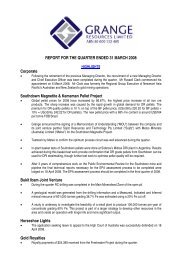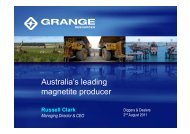2012 Annual Report (2 April 2013) - Grange Resources
2012 Annual Report (2 April 2013) - Grange Resources
2012 Annual Report (2 April 2013) - Grange Resources
Create successful ePaper yourself
Turn your PDF publications into a flip-book with our unique Google optimized e-Paper software.
<strong>2012</strong> ANNUAL REPORT<br />
47<br />
PAGE<br />
Notes to the Financial Statements<br />
NOTE 1. SUMMARY OF SIGNIFICANT<br />
ACCOUNTING POLICIES<br />
The principal accounting policies adopted in the preparation<br />
of the consolidated financial statements are set out below.<br />
These policies have been consistently applied for all the periods<br />
presented, unless otherwise stated.<br />
The financial statements are for the consolidated entity consisting<br />
of <strong>Grange</strong> <strong>Resources</strong> Limited and its subsidiaries.<br />
(a) Basis of preparation<br />
This general purpose financial report has been prepared<br />
in accordance with Australian Accounting Standards and<br />
Interpretations issued by the Australian Accounting Standards<br />
Board and the Corporations Act 2001.<br />
Compliance with IFRS<br />
The consolidated financial statements of the <strong>Grange</strong> <strong>Resources</strong><br />
Limited group also comply with International Financial <strong>Report</strong>ing<br />
Standards (IFRS) as issued by the International Accounting<br />
Standards Board (IASB).<br />
Historical cost convention<br />
These financial statements have been prepared under the<br />
historical costs convention, except for certain assets which, as<br />
noted, are at fair value.<br />
Critical accounting estimates<br />
The preparation of financial statements requires the use of certain<br />
critical accounting estimates. It also requires management to<br />
exercise its judgement in the process of applying the Group’s<br />
accounting policies. The areas involving a higher degree of<br />
judgement or complexity, or areas where assumptions and<br />
estimates are significant to the financial statements, are disclosed<br />
in Note 3.<br />
(b)<br />
Principles of consolidation<br />
(i) Subsidiaries<br />
The consolidated financial statements incorporate the assets<br />
and liabilities of all subsidiaries of <strong>Grange</strong> <strong>Resources</strong> Limited as<br />
at 31 December <strong>2012</strong> and the results of all subsidiaries for the<br />
year then ended. <strong>Grange</strong> <strong>Resources</strong> Limited and its subsidiaries<br />
together are referred to in this financial report as the Group or the<br />
consolidated entity.<br />
Subsidiaries are fully consolidated from the date on which control<br />
is transferred to the Group. They are de-consolidated from the<br />
date that control ceases. Details of subsidiaries are set out in<br />
Note 36.<br />
The acquisition method of accounting is used to account for<br />
business combinations by the Group (refer to note 1(e)).<br />
The Group applies a policy of treating transactions with minority<br />
interests as transactions with parties external to the Group.<br />
Disposals of minority interests result in gains and losses for the<br />
Group that are recorded in the income statement. Purchases of<br />
minority interests result in goodwill, being the difference between<br />
any consideration paid and the relevant share acquired of the<br />
carrying value of the identifiable net assets of the subsidiary.<br />
Minority interests in the results and equity of subsidiaries are<br />
shown separately in the consolidated income statement and<br />
balance sheet respectively.<br />
Intercompany transactions, balances and unrealised gains<br />
on transactions between Group companies are eliminated.<br />
Unrealised losses are also eliminated unless the transaction<br />
provides evidence of the impairment of the asset transferred.<br />
Accounting policies of subsidiaries have been changed where<br />
necessary to ensure consistency with the policies adopted by the<br />
Group.<br />
Investments in subsidiaries are accounted for at cost in the<br />
individual financial statements of <strong>Grange</strong> <strong>Resources</strong> Limited.<br />
(ii) Joint Ventures<br />
Jointly controlled assets<br />
The proportionate interests in the assets, liabilities and expenses<br />
of a joint venture activity have been incorporated into the financial<br />
statements under the appropriate headings. Details of joint<br />
ventures are set out in Note 37.<br />
Where part of a joint venture interest is farmed out in<br />
consideration of the farm-in party undertaking to incur further<br />
expenditure on behalf of both the farm-in party and the entity in<br />
the joint venture area of interest, exploration expenditure incurred<br />
and carried forward prior to farm out continues to be carried<br />
forward without adjustment. Any cash received in consideration<br />
for farming out part of a joint venture interest is treated as a<br />
reduction in the carrying value of the related mineral property.<br />
Subsidiaries are those entities over which the Group has the<br />
power to govern the financial and operating policies, generally<br />
accompanying a shareholding of more than one-half of the voting<br />
rights. The existence and effect of potential voting rights that<br />
are currently exercisable or convertible are considered when<br />
assessing whether the Group controls another entity.



